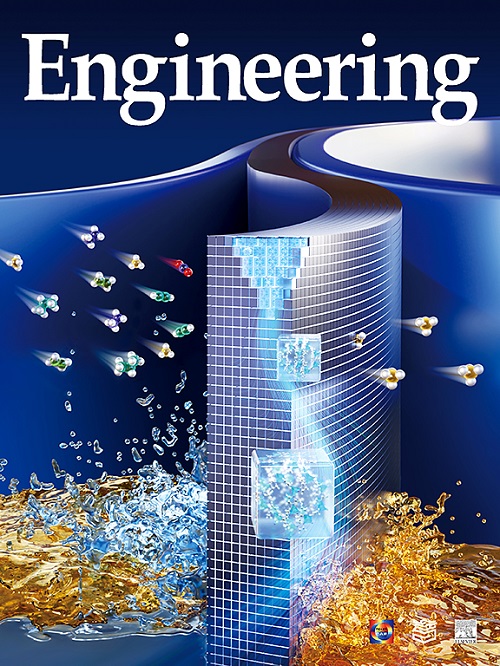煤矿采空区充填CO2矿化全固废胶凝材料及固碳潜力评价
IF 10.1
1区 工程技术
Q1 ENGINEERING, MULTIDISCIPLINARY
引用次数: 0
摘要
煤炭是全球能源的重要组成部分;然而,煤炭开采利用过程中产生了大量的采空区,伴随着煤基固体废弃物和排放的二氧化碳,给生态环境带来了严峻的挑战。针对这一问题,本研究提出了一种利用煤基固体废弃物与浓度为15%的CO2矿化制备胶凝材料充填煤矿采空区的新方法。各固体废物的固碳能力排序如下:电石渣(CS) >;赤泥(RM) >;粉煤灰。利用复合固体废弃物(FA-CS-RM)与CO2矿化制备的充填材料性能满足采空区充填要求。CO2矿化获得的充填材料(F60C20R20)最大抗压强度为14.9 MPa,比未矿化材料提高32.2%。制备的填料具有良好的CO2固存能力(最大CO2固存量为14.4 kg·t−1)。根据固碳潜力分析,到2023年,中国FA、CS和RM的年产量分别约为899,30,107 Mt。单独利用FA、CS和RM分别可实现3.42、10.78和0.61 Mt的碳减排。CO2矿化复合固体废物(FA-CS-RM)可实现碳减排123 Mt。此外,以中国黄河流域为例,估计2016 - 2030年煤矿采空区地下空间总量为8.16 Gm3,表明该技术可封存0.18 Gt CO2。该方法为大规模的烟气CO2固存、煤基固体废弃物的循环利用、煤矿采空区的修复提供了一种有前景的解决方案,有助于煤炭的绿色利用和碳的减排。本文章由计算机程序翻译,如有差异,请以英文原文为准。
CO2 Mineralized Full Solid Waste Cementitious Material for Coal Mine Goaf Filling and Carbon Sequestration Potential Assessment
Coal is an essential component of global energy; however, the processes of coal mining and utilization produce significant amounts of coal mine goafs, accompanied by coal-based solid wastes and emitted CO2, resulting in severe ecological and environmental challenges. In response to this issue, this study proposes a novel approach for filling coal mine goafs using cementitious materials prepared by coal-based solid wastes mineralized with CO2 (15% in concentration). The CO2 sequestration capacities of individual solid wastes are ranked as follows: carbide slag (CS) > red mud (RM) > fly ash (FA). The performance of filling material prepared from composite solid waste (FA–CS–RM) mineralized with CO2 meets the filling requirements of goaf. The filling material (F60C20R20) obtained by CO2 mineralization was 14.9 MPa in maximum compressive strength, increasing by 32.2% compared to the non-mineralized material. The prepared filling material exhibits excellent CO2 sequestration capacity (i.e., 14.4 kg·t−1 in maximum amount of CO2 sequestration). According to the analysis of carbon sequestration potential, in China, the annual production of FA, CS, and RM is approximately 899, 30, and 107 Mt, respectively in the year of 2023. The utilization of FA, CS, and RM individually can achieve carbon emission reductions of 3.42, 10.78, and 0.61 Mt, respectively. The composite solid waste (FA–CS–RM) mineralized with CO2 can achieve 1.23 Mt in carbon emissions reduction. Additionally, taking Yellow River Basin of China as a case study, the total volume of underground space in coal mine goafs from 2016 to 2030 is estimated at 8.16 Gm3, indicating that this technology can sequester 0.18 Gt of CO2. This approach offers a promising solution for large-scale flue gas CO2 sequestration, recycling coal-based solid wastes, and remediating coal mine goafs, contributing to green utilization of coal and the emission reduction of carbon.
求助全文
通过发布文献求助,成功后即可免费获取论文全文。
去求助
来源期刊

Engineering
Environmental Science-Environmental Engineering
自引率
1.60%
发文量
335
审稿时长
35 days
期刊介绍:
Engineering, an international open-access journal initiated by the Chinese Academy of Engineering (CAE) in 2015, serves as a distinguished platform for disseminating cutting-edge advancements in engineering R&D, sharing major research outputs, and highlighting key achievements worldwide. The journal's objectives encompass reporting progress in engineering science, fostering discussions on hot topics, addressing areas of interest, challenges, and prospects in engineering development, while considering human and environmental well-being and ethics in engineering. It aims to inspire breakthroughs and innovations with profound economic and social significance, propelling them to advanced international standards and transforming them into a new productive force. Ultimately, this endeavor seeks to bring about positive changes globally, benefit humanity, and shape a new future.
 求助内容:
求助内容: 应助结果提醒方式:
应助结果提醒方式:


